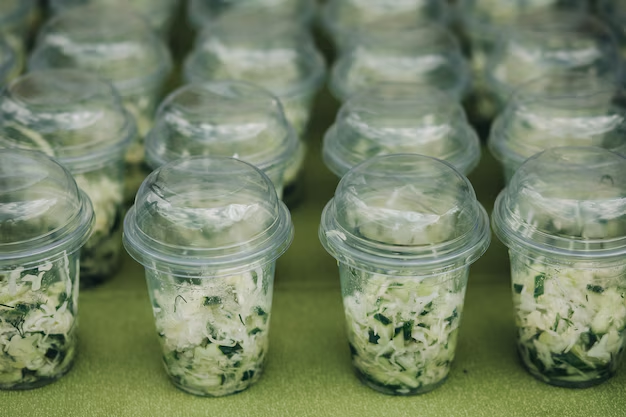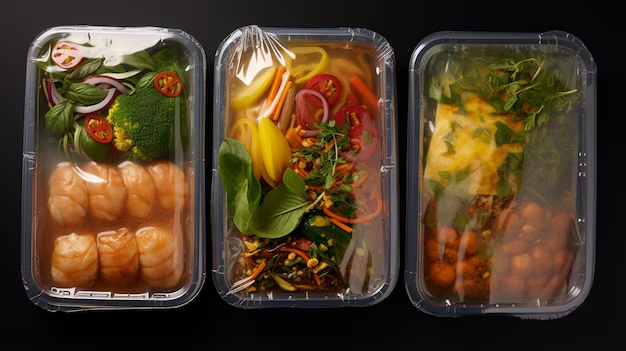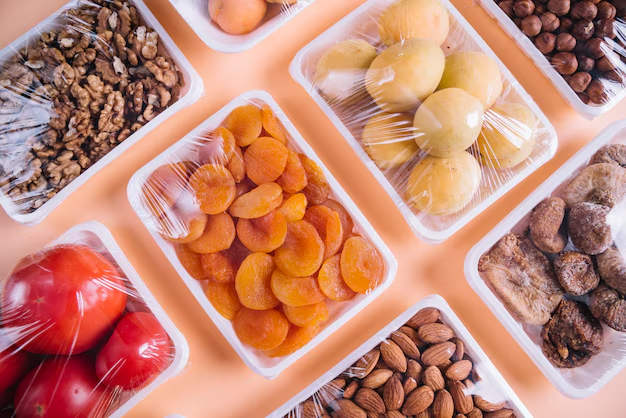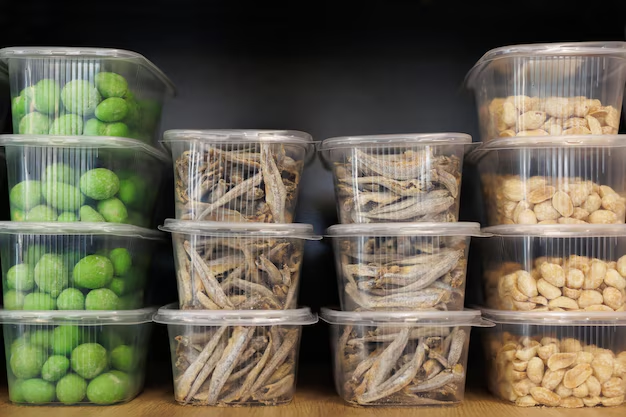Table of Contents
Introduction
The use of plastic in food packaging has become an integral part of modern life. From the moment you step into a supermarket, you are surrounded by plastic-wrapped fruits, ready-to-eat meals in plastic trays, and beverages in plastic bottles. While plastic has transformed the way we store and transport food, offering convenience and affordability, it has also introduced several health and environmental concerns.
Most people rarely think about how food interacts with its packaging. However, studies reveal that chemicals from plastics can leach into food, affecting both its quality and safety. Furthermore, plastic waste contributes significantly to environmental pollution, adding another layer of complexity to this issue. This article delves deep into the role of plastic in food packaging, its potential risks, and what you can do to minimize its impact on your health and the planet.
The Role of Plastic in Food Packaging
Why Plastic is Popular for Food Packaging
Plastic is widely used for food packaging due to its numerous advantages. Unlike materials such as glass or metal, plastic is lightweight and easy to mold into different shapes, making it versatile for a variety of food products. Additionally, its cost-effectiveness has made it the go-to choice for manufacturers looking to minimize production expenses.
Plastic also excels at providing a barrier against moisture, air, and contaminants, which helps preserve food for longer periods. For example, vacuum-sealed plastic packaging keeps meats and cheeses fresh by limiting exposure to oxygen. This preservation quality reduces food waste, a significant concern in global food supply chains.
However, its ubiquity in the food industry has raised questions about its safety and environmental impact, prompting a closer examination of how it affects what we eat.

Common Types of Plastics Used in Food Packaging
Plastics used in food packaging are not all the same. Here’s a breakdown of the most commonly used types:
- PET (Polyethylene Terephthalate):
Found in water bottles, soft drink containers, and salad dressing bottles, PET is favored for its clarity and strength. It is also recyclable, although not all PET products make it through the recycling process. - HDPE (High-Density Polyethylene):
Commonly used in milk jugs, juice bottles, and yogurt tubs, HDPE is known for its durability and resistance to chemicals. - PVC (Polyvinyl Chloride):
This plastic is often used in cling wraps and blister packs. However, PVC has raised health concerns due to the release of harmful chemicals during production and disposal. - LDPE (Low-Density Polyethylene):
Bread bags and squeeze bottles are typically made from LDPE, which is flexible and lightweight. - PP (Polypropylene):
Found in microwavable containers and snack wrappers, PP is heat-resistant and considered relatively safe for food storage.
Each type has its specific applications, but they all share a common issue: the potential for chemical leaching into food, especially when exposed to heat or acidic substances.

Key Benefits of Plastic Packaging
Despite its drawbacks, plastic packaging offers undeniable advantages:
- Preservation of Freshness: Plastic acts as a barrier to air and moisture, which helps extend the shelf life of perishable goods. This is particularly beneficial in reducing food waste, especially in regions with limited access to refrigeration.
- Protection from Contamination: Airtight seals and tamper-proof designs minimize the risk of bacteria and other contaminants affecting the food.
- Convenience: Plastic’s lightweight nature makes it ideal for on-the-go lifestyles, allowing consumers to easily transport food and beverages.
- Cost Savings: Plastic packaging is cheaper to produce and transport compared to alternatives like glass or metal, making it an economically viable choice for manufacturers and consumers alike.
While these benefits have made plastic indispensable in food packaging, they come at a hidden cost to health and the environment.

How Plastic Interacts with Food
Chemical Migration from Plastics into Food
One of the most concerning aspects of plastic food packaging is chemical migration, where substances from the plastic leach into the food it contains. This process can occur at any stage of the product’s lifecycle, from manufacturing and storage to cooking and consumption.
Studies have shown that certain additives in plastics, such as plasticizers, stabilizers, and colorants, are prone to migrating into food, especially under specific conditions. For instance, heating plastic containers in a microwave significantly increases the rate of chemical transfer, as does storing acidic or oily foods in plastic.
Factors That Influence Chemical Migration
Several factors determine how much and how quickly chemicals migrate from plastic into food:
- Heat Exposure: Heating food in plastic containers, whether in a microwave or oven, accelerates the breakdown of plastic molecules, increasing the likelihood of chemical leaching.
- Storage Duration: The longer food remains in plastic packaging, the greater the chances of chemical migration.
- Type of Food: Acidic and fatty foods, such as tomato-based sauces and oils, are particularly susceptible to absorbing chemicals from plastic.
- Quality of Plastic: Single-use plastics are more prone to leaching than higher-quality reusable containers.
Understanding these factors can help consumers make informed decisions about their food storage and consumption habits.

Health Risks Associated with Plastic Packaging
Exposure to Harmful Chemicals
Plastic packaging often contains additives like BPA (Bisphenol A), phthalates, and other potentially toxic substances. These chemicals serve to enhance the durability, flexibility, and functionality of the packaging but can pose serious health risks when ingested.
- BPA: Found in polycarbonate plastics and epoxy resins, BPA has been linked to hormonal imbalances and reproductive issues.
- Phthalates: Used to increase the flexibility of plastics, phthalates are associated with developmental problems, particularly in children.
- Heavy Metals: Some plastics may contain trace amounts of heavy metals like lead and cadmium, which are toxic even in small doses.
Potential Health Effects
Prolonged exposure to harmful chemicals in plastics can lead to a range of health issues:
- Endocrine Disruption: Chemicals like BPA mimic hormones, interfering with the body’s natural hormonal processes and potentially leading to fertility problems and developmental disorders.
- Increased Cancer Risks: Some studies have linked prolonged exposure to plastic additives with an elevated risk of cancers, particularly breast and prostate cancer.
- Neurological Effects: Research suggests that certain chemicals in plastics may impact brain development in infants and children, leading to behavioral and cognitive issues.
Environmental Impacts of Plastic in Food Packaging
Plastic Waste and Pollution
The global reliance on plastic food packaging has led to a massive increase in plastic waste. According to studies, over 40% of all plastic produced is used for packaging, much of which is single-use and ends up in landfills or oceans. Plastic waste not only contributes to environmental degradation but also takes hundreds of years to decompose.
Microplastics in the Food Chain
As plastics degrade, they break down into smaller particles known as microplastics, which are now pervasive in the environment. These tiny particles have been detected in water supplies, marine life, and even table salt. When humans consume contaminated seafood or water, microplastics can enter our bodies, posing unknown health risks.
Safer Alternatives to Plastic in Food Packaging
Biodegradable and Compostable Packaging
In response to the environmental crisis caused by plastic, biodegradable and compostable materials have emerged as viable alternatives. Made from renewable resources like cornstarch, bamboo, or sugarcane, these materials decompose more quickly and have a lower environmental impact.
Reusable and Non-Plastic Options
Consumers can also opt for reusable and non-plastic packaging solutions, such as:
- Glass Containers: Ideal for storing food without the risk of chemical leaching.
- Stainless Steel: Durable and eco-friendly, perfect for transporting meals.
- Paper-Based Packaging: Coated with non-toxic materials to resist moisture, paper-based options are gaining traction in the food industry.
Steps to Minimize Plastic Exposure from Food Packaging
Choosing the Right Packaging
To reduce your exposure to harmful chemicals, pay attention to the type of plastic used in food packaging. Avoid products labeled with recycling codes 3 (PVC) and 7 (Miscellaneous), which often contain harmful additives. Instead, choose packaging with codes 2 (HDPE), 4 (LDPE), or 5 (PP), which are considered safer.
Proper Storage Practices
Adopting safer storage practices can also minimize risks:
- Transfer hot food to glass or stainless steel containers instead of storing it in plastic.
- Avoid microwaving food in plastic containers, even if they are labeled “microwave-safe.”
- Limit the use of single-use plastics, which are more prone to leaching.
Innovations in Sustainable Food Packaging
Advances in Plant-Based Plastics
Researchers are developing plant-based plastics made from algae, mushroom mycelium, and cornstarch. These materials not only reduce dependency on fossil fuels but also decompose faster, making them more sustainable alternatives to traditional plastics.
Role of Industry and Regulations
Governments and industries are taking steps to address the risks associated with plastic packaging. Policies banning single-use plastics and promoting eco-friendly alternatives are gaining momentum worldwide. Consumers can support these initiatives by choosing brands that prioritize sustainability.
Conclusion
Plastic food packaging has revolutionized convenience but at a significant cost to our health and the environment. By understanding how plastic interacts with food and adopting safer alternatives, we can reduce these risks and contribute to a more sustainable future. Whether it’s choosing reusable containers or supporting eco-conscious brands, every small change can make a big difference.
FAQs
- How does plastic packaging affect food quality?
Plastic can leach chemicals into food, altering its taste and safety. - What are the most harmful chemicals in plastic packaging?
BPA, phthalates, and heavy metals are among the most harmful. - Can I safely reuse plastic food containers?
It’s best to avoid reusing single-use plastics and choose containers designed for multiple uses. - What are the best alternatives to plastic for food storage?
Glass, stainless steel, and paper-based packaging are excellent options. - How can I reduce my reliance on plastic packaging?
Buy in bulk, use reusable containers, and choose products with eco-friendly packaging.
